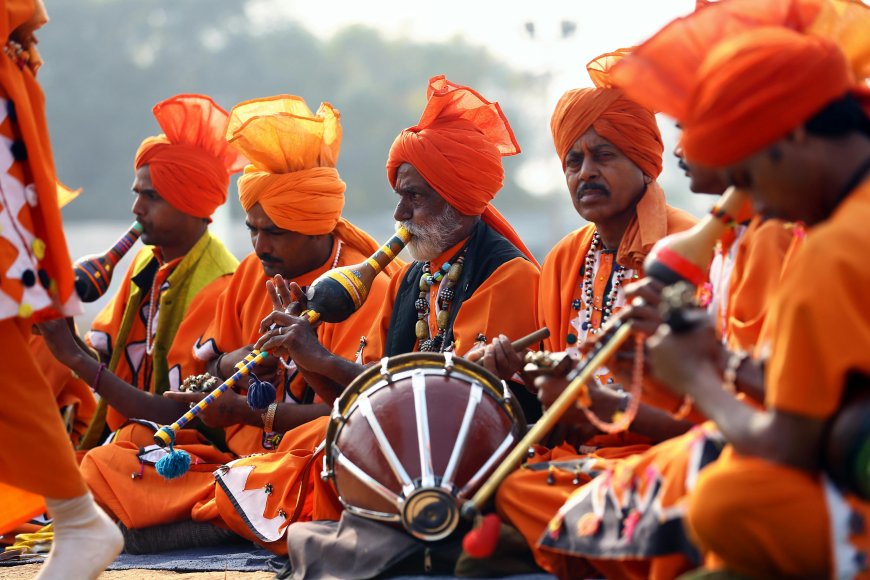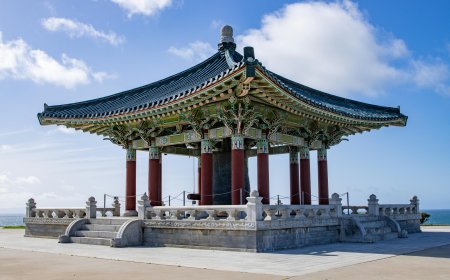The traditional art and music of India
The traditional art and music of India are distinguished by being a reflection of its deep and rich heritage, embodying the diversity of cultures and traditions in this ancient country. Traditional Indian art is characterized by vibrant colors and intricate geometric designs, while traditional Indian music emanates from traditional musical instruments such as the sitar, tabla, and tambura.

The traditional art and music of India are distinguished by being a reflection of its deep and rich heritage, embodying the diversity of cultures and traditions in this ancient country. Traditional Indian art is characterized by vibrant colors and intricate geometric designs, while traditional Indian music emanates from traditional musical instruments such as the sitar, tabla, and tambura.
The traditional art and music of India
Traditional Indian art is an integral part of India's rich cultural heritage, reflecting a vast diversity of arts and creative practices that express the national identity and cultural spirit of the country. Traditional Indian art is characterized by a variety of techniques and styles, including painting, sculpture, textiles, architecture, dance, and music.
In the realm of painting, traditional Indian art serves as a source of inspiration for many artists around the world. The vibrant colors and intricate embellishments of Bharatanatyam art are renowned, while Rajput art showcases stunning drawing techniques that depict details with exceptional precision. In sculpture, Indian sculptures are distinguished by their unique and distinctive style, with a focus on representing deities and Indian myths.
In architecture, Hindu, Buddhist, and Islamic influences are prominent in traditional Indian architecture, with monumental structures and religious temples exhibiting unique architectural styles that reflect the country's different religions and cultural diversity.
In the field of dance and music, traditional Indian art is renowned for its vast diversity, ranging from classical Indian to folk forms. Classical Indian dance styles such as Kathak and Bharatanatyam are among the most famous, while traditional musical instruments like the sitar, tambura, and tabla are integral parts of this rich musical heritage.
Overall, traditional Indian art embodies a mirror reflecting cultural diversity and unique creative spirit, retaining its significant place as part of the Indian national identity and serving as a source of pride for the Indian people, representing an invaluable heritage.
Manifestations of beauty and diversity
The manifestations of beauty and diversity in traditional Indian art are essential components of its rich and diverse artistic heritage. Beauty in traditional Indian art is expressed through the use of vibrant colors and beautiful ornamentation that reflect deep cultural heritage and unique creative spirit.
In visual arts such as painting and sculpture, the aesthetic manifestations appear in the use of elegant lines and intricate geometric shapes to portray various subjects, whether religious, cultural, or natural. Traditional Indian paintings are characterized by their wide variety of subjects, ranging from stunning landscapes to exquisite religious sculptures, reflecting the cultural diversity and natural beauty of India.
In architecture, the aesthetic diversity is evident in the designs of Indian temples and palaces, where shapes, decorations, and ornamental details vary between traditional Indian architecture and influences from Islam and Buddhism, creating a unique blend of beauty and diversity.
In music and dance, diversity is showcased through the use of a variety of traditional musical instruments and unique dance styles, creating diverse musical atmospheres that express a rich and diverse cultural heritage.
Overall, it can be said that the beauty and diversity in traditional Indian art reflect the richness and complexity of Indian culture, and they are essential elements in enriching the artistic and cultural experience of India and the world as a whole.
Traditional Indian music heritage
The heritage of traditional Indian music is an integral part of traditional Indian art, reflecting the richness of cultural diversity and the country's deep history. This heritage is characterized by complexity and depth, blending authenticity and innovation at the same time.
Traditional Indian music is distinguished by a wide variety of styles, sounds, and musical instruments used. These instruments include drums, tabla, sitar, sarangi, shehnai, tambura, flute, harmonium, and many others. Each instrument plays a unique role in imparting a distinctive character to the musical performance.
The systems of traditional Indian music, such as ragas and talas, are among the most important elements that distinguish this heritage. These systems provide ample space for creativity and expression, allowing traditional artists to develop and expand their skills and showcase their individual talents.
Among the most important traditional Indian music styles are classical Indian music, folk music, and devotional music. Classical music emphasizes vocal beauty and complex musical techniques, while folk music reflects the popular spirit and folk traditions of India. Devotional music expresses reverence and worship and is associated with religious rituals and occasions.
Overall, the heritage of traditional Indian music is a source of pride and pride for the Indian people, preserving the country's history and culture through beautiful and diverse melodies that tell ancient stories and express feelings and life experiences.
Traditional Indian dance art
Traditional Indian dance art forms an important part of India's rich cultural heritage, embodying the diversity of cultures and traditions in this ancient country. Traditional Indian dance is characterized by its great diversity, encompassing a variety of styles and techniques that vary from region to region.
One of the most important styles of traditional Indian dance is classical dance, which includes several forms such as Bharatanatyam, Kathak, Kuchipudi, Mohiniyattam, and others. Indian classical dance is characterized by deep expression and a focus on the harmony between movement, rhythm, and emotional expression.
In addition to classical dance, there is also Indian folk dance that reflects the daily life of ordinary people. Folk dance includes a variety of styles such as Bhangra, Goomar, Rajasthani, and folk.
Traditional Indian dance is considered a means of expressing cultural identity, values, and beliefs. Traditional attire and prominent makeup are integral parts of Indian dance performance, contributing to creating an atmosphere of beauty and elegance.
Schools and artistic institutes that teach traditional Indian dance are key stations for transmitting this cultural heritage to the new generations. Dance performances and Indian cultural festivals around the world serve to promote traditional Indian dance art and introduce other communities to its beauty and diversity.
In this way, traditional Indian dance is not just a form of entertainment, but a means of cultural communication and deep artistic expression, remaining a vital part of India's cultural identity and rich heritage.
The impact of creativity and technology
The impact of creativity and technology on traditional Indian art reflects a continuous evolution and rich diversity across the ages, where traditional artistic skills merge with modern techniques to produce exceptional and innovative artworks.
In the fields of painting and sculpture, traditional artists employ advanced techniques to develop their styles and enhance their artistic expression. For example, artists may use modern tools such as synthetic colors and brushes to add contemporary aesthetics to their paintings while retaining traditional drawing techniques such as shading, light, and compositional balance.
In architecture, traditional designs are integrated with modern technology to create unique buildings. Computer software and three-dimensional design are used to develop and analyze building designs, while preserving traditional cultural elements in decorations and architectural motifs.
In dance and music, modern technologies are combined with traditional styles to produce innovative and stunning performances. For instance, lighting techniques and special effects in dance performances create magical atmospheres and highlight dancers' movements exceptionally.
In this way, creativity and technology contribute to the development of traditional Indian art, enhancing its aesthetics and artistic expression in a more advanced manner. This contributes to the revival of this rich cultural heritage and its transmission to future generations in a renewed and innovative way.
Harmony between local instruments and features
The harmony between local instruments and features in traditional Indian art represents a deep integration of musical and cultural elements, with the beauty of the art and music expressing the Indian identity and spirit in an authentic and profound manner.
Traditional musical instruments in India are characterized by their diversity and multiplicity, forming an integral part of Indian musical heritage. For example, instruments such as the sitar, tabla, tambourine, sarangi, shehnai, tambura, and flute all reflect deep traditions and rich heritage in Indian music.
Each type of instrument has its unique features, whether it's string instruments like the sitar known for its deep and sensual tones, or percussion instruments like the tabla adding vitality and dynamism to musical performances.
In addition to musical instruments, traditional Indian art is characterized by local and cultural features manifested in artistic performances. This includes the use of local language in song lyrics and poetry, as well as the use of traditional dances and movements that express a specific culture or geographical region.
Furthermore, traditional attire and prominent makeup in local Indian artistic performances reflect the culture and local heritage, adding a touch of beauty and authenticity to the artistic performance.
In this way, the harmony between local instruments and features in traditional Indian art embodies the Indian spirit in every aspect of musical and artistic performance, enhancing cultural heritage and preserving local identity in the face of modern challenges.
Characteristics of traditional Indian art
Characteristics of traditional Indian art constitute a genuine expression of India's rich culture and heritage, reflecting the aesthetic beauty of traditional arts and the cultural diversity that distinguishes this ancient country.
1. Painting and Sculpture: Artistic paintings and sculptural works are among the prominent features of traditional Indian art. Themes vary from nature to religions and myths, characterized by vibrant colors and intricate details that convey deep meanings.
2. Architecture: Traditional Indian art in architecture is distinguished by magnificent Hindu temples, beautiful Islamic mosques, and historic palaces. Geometric patterns, arches, and domes stand out as distinctive elements in building designs.
3. Dance: Traditional Indian art is renowned for its diverse dance styles, such as Bharatanatyam, Kathak, Kuchipudi, and Mohiniyattam. Each style is characterized by unique movements and techniques that reflect the local culture and heritage.
4. Music: Traditional Indian music encompasses a wide range of instruments and styles, such as sitar, tabla, tambura, sarangi, and more. Indian traditional music reflects the diversity of sounds, melodies, and rhythms that distinguish the musical culture in India.
5. Costume and Makeup: Traditional attire and prominent makeup are essential parts of traditional Indian artistic landmarks. Attires, clothing, and jewelry vary according to culture and occasion, while makeup is characterized by vibrant colors, religious symbols, and cultural traditions.
The landmarks of traditional Indian art are a comprehensive and aesthetic expression of Indian identity and heritage, highlighting the diversity and cultural richness that characterize this unique country.
Summary
Traditional art and music in India constitute an essential part of the rich cultural heritage of this ancient country. Indian traditional art is characterized by its vast diversity and multiple styles, including painting, sculpture, architecture, dance, and music. Traditional Indian music is distinguished by its unique musical instruments and diverse styles such as classical, folk, and religious music. Similarly, traditional Indian dance showcases a variety of styles and movements that reflect the cultural and spiritual heritage of India. Traditional Indian art combines creativity, beauty, and technique to produce artistic works that express the national identity and deep heritage of India.
Sources
1. Indian Classical Music
- Wikipedia: Provides a comprehensive article about Indian classical music, its history, and various styles.
2. Ghazal Music
- BBC article: Discusses the origins and evolution of Ghazal music in India, as well as prominent singers and musicians in this musical genre.
3. Indian Classical Dance
- MyLearning website: Offers courses and articles about Indian classical dance, including its origins and different styles like Bharatanatyam and Kathak.
What's Your Reaction?



































































































































































